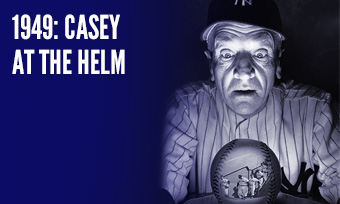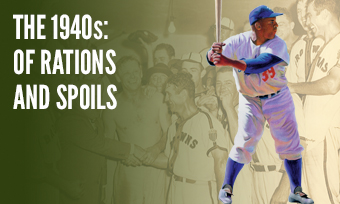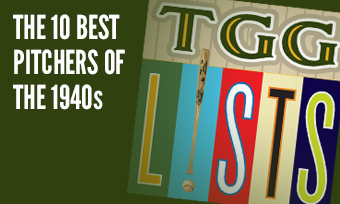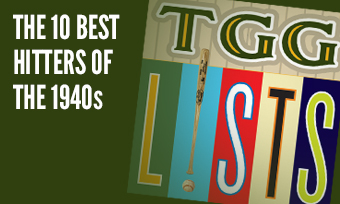The Yearly Reader
Leaders and Honors, 1949
Our list of baseball’s top 10 hitters and pitchers in both the American League and National League for the 1949 baseball season, as well as the awards and honors given to the game’s top achievers of the year.
The National League’s Top 10 Hitters, 1949
Bold type in brick red indicates league leader.
1. Stan Musial, St. Louis
Key Numbers: 157 games, .338 average, 128 runs, 207 hits, 41 doubles, 13 triples, 35 home runs, 123 RBIs, 107 walks, .438 on-base percentage.
For the seventh straight year, Musial achieved baseball’s triple-double with at least 10 doubles, triples and home runs each; he also collected the lone cycle of his storied career.
2. Ralph Kiner, Pittsburgh
Key Numbers: .310 average, 116 runs, 170 hits, 54 home runs, 127 RBIs, 117 walks, .658 slugging percentage.
Kiner blazed to the finish with 16 September homers to become the NL’s first player to reach 50 twice.
3. Jackie Robinson, Brooklyn
Key Numbers: .342 average, 122 runs, 203 hits, 38 doubles, 12 triples, 16 home runs, 124 RBIs, 86 walks, 17 sacrifice hits, 37 stolen bases, 16 caught stealing.
Robinson was never better than in 1949—and despite towering numbers by Stan Musial and Ralph Kiner (above), he was still a worthy choice for the NL MVP.
4. Enos Slaughter, St. Louis
Key Numbers: .336 average, 92 runs, 191 hits, 34 doubles, 13 triples, 13 home runs, 96 RBIs, 79 walks.
It was only fitting that Slaughter and Musial tied for the NL lead in triples; they were the pacesetters in that department for all of the 1940s.
5. Carl Furillo, Brooklyn
Key Numbers: .322 average, 95 runs, 177 hits, 27 doubles, 10 triples, 18 home runs, 106 RBIs.
From August 8 on, Furillo hit a mind-boggling .431 to finish the season over .300 for the first time in his career.
6. Del Ennis, Philadelphia
Key Numbers: .302 average, 92 runs, 184 hits, 39 doubles, 11 triples, 25 home runs, 110 RBIs.
Offensively, Ennis’ superior numbers were one of the prime reasons the Phillies recorded their first winning record in 17 years.
7. Bobby Thomson, New York
Key Numbers: .309 average, 99 runs, 198 hits, 35 doubles, 9 triples, 27 home runs, 109 RBIs, 10 stolen bases.
As we all found out in 1951, Thomson loved pulling the ball to the cozily-placed left-field bleachers at the Polo Grounds; 19 of his 27 homers came at home.
8. Pee Wee Reese, Brooklyn
Key Numbers: .279 average, 132 runs, 172 hits, 27 doubles, 16 home runs, 73 RBIs, 116 walks, 26 stolen bases.
The emergence of Brooklyn’s “Boys of Summer” roster clearly rubbed off on the veteran Reese, who set career marks in runs, home runs and walks.
9. Duke Snider, Brooklyn
Key Numbers: .292 average, 100 runs, 28 doubles, 7 triples, 23 home runs, 92 RBIs, 12 stolen bases, 92 strikeouts.
The breakout campaign for the 22-year-old Snyder included a nifty .338 average with runners in scoring position—telegraphing to veteran pitchers that intimidation tactics against him were useless.
10. Sid Gordon, New York
Key Numbers: .284 average, 87 runs, 26 doubles, 26 home runs, 90 RBIs, 95 walks, 24 grounded into double plays.
In his last year with the Giants, Gordon would belt two homers in one inning, at Cincinnati on July 31; he’d hit only three more over the team’s final 60 games.
The American League’s Top 10 Hitters, 1949
1. Ted Williams, Boston
Key Numbers: 155 games, .343 average, 150 runs, 194 hits, 39 doubles, 43 home runs, 159 RBIs, 162 walks, .490 on-base percentage, .650 slugging percentage.
Amazing as it may seem to the casual baseball fan, Williams never cranked out 200 hits in any one year—but he came closest in 1949. His shot at an unprecedented third triple crown was thwarted on the last day by George Kell, who took the AL batting title by a .00016 margin.
2. Vern Stephens, Boston
Key Numbers: 155 games, .290 average, 113 runs, 177 hits, 31 doubles, 39 home runs, 159 RBIs, 101 walks.
Partnering with Williams, Stephens became the fourth duo—and last, to-date—to each knock in 150+ RBIs in one season; Williams volunteered that Vern Stephens protected him in the lineup better than any other hitter he played with.
3. Eddie Joost, Philadelphia
Key Numbers: .355 average, 116 runs, 199 hits, 34 doubles, 6 triples, 18 home runs, 106 RBIs, 98 walks.
With more walks than hits, Eddie Joost led the invasion of the leadoff hitters named Eddie (Stanky, Yost) who lived for ball four.
4. Vic Wertz, Detroit
Key Numbers: 155 games, .304 average, 96 runs, 185 hits, 26 doubles, 6 triples, 20 home runs, 133 RBIs, 80 walks.
Channeling former Tigers star Hank Greenberg, Wertz was averaging over one RBI a game into early July before ‘cooling’ off.
5. Bobby Doerr, Boston
Key Numbers: .309 average, 91 runs, 167 hits, 30 doubles, 9 triples, 18 home runs, 109 RBIs, 75 walks, 31 grounded into double plays.
After a terribly slow start that saw him hitting .213 on June 25, Doerr cranked it up with a .367 mark afterward.
6. Tommy Henrich, New York
Key Numbers: 115 games, .287 average, 90 runs, 24 home runs, 85 RBIs, 86 walks.
Henrich was tied with three other players for a distant third on the AL home run charts (behind Ted Williams and Vern Stephens); he might have been much closer had he not missed 40 games.
7. Dom DiMaggio, Boston
Key Numbers: .307 average, 126 runs, 186 hits, 34 doubles, 5 triples, 8 home runs, 60 RBIs, 96 walks.
It wasn’t 56, but DiMaggio’s 34-game hit streak from 1949 is certified as the longest in Red Sox history.
8. Larry Doby, Cleveland
Key Numbers: .280 average, 106 runs, 25 doubles, 24 home runs, 85 RBIs, 91 walks, 7 hit-by-pitches, 10 stolen bases.
The AL’s first African-American was hit more often than any other ballplayer (excepting Washington’s Eddie Robinson, who tied Doby) and began a troubling trend in which black players topped the HBP lists for all but one of the next 13 years.
9. George Kell, Detroit
Key Numbers: 134 games, .343 average, 97 runs, 179 hits, 38 doubles, 8 triples, 3 home runs, 59 RBIs, 71 walks.
The future Hall of Famer snared his lone career batting title on the final day by going 2-for-3—while Ted Williams, who led by three batting points going into the day, went hitless in two at-bats.
10. Johnny Pesky, Boston
Key Numbers: .306 average, 111 runs, 185 hits, 27 doubles, 7 triples, 2 home runs, 69 RBIs, 100 walks.
Pesky wasn’t collecting up and over 200 hits any more, but he was making up for it by attracting more walks—which explains how his on-base percentage remained stable.
The National League’s Top 10 Pitchers, 1949
1. Howie Pollet, St. Louis
Key Numbers: 2.77 ERA, 20 wins, 9 losses, .690 win percentage, 39 appearances, 28 starts, 5 shutouts, 230.2 innings.
Almost too scared to throw hard after two off-years complicated by elbow injuries, Pollet swallowed his fear and neared his superb 1946 form.
2. Warren Spahn, Boston
Key Numbers: 3.07 ERA, 21 wins, 14 losses, 38 starts, 25 complete games, 302.1 innings, 151 strikeouts.
Spahn provided the only upside to a Braves team plagued by dissension and a horrid off-year for staffmate Johnny Sain.
3. Don Newcombe, Brooklyn
Key Numbers: 3.17 ERA, 17 wins, 8 losses, .680 win percentage, 38 appearances, 31 starts, 5 shutouts, 244.1 innings.
Newcombe threw the first shutout by a NL pitcher in his debut since 1938.
4. Dave Koslo, New York
Key Numbers: 2.50 ERA, 11 wins, 14 losses, 38 appearances, 23 starts, 212 innings, 43 walks.
Not only did Koslo become the first ERA leader without a shutout, he also had the lowest win percentage by such a titlist since 1902.
5. Preacher Roe, Brooklyn
Key Numbers: 2.79 ERA, 15 wins, 6 losses, .714 win percentage, 212.2 innings, 44 walks.
His pitches likely never wetter—his numbers certainly never better—the occasional spitball artist began a five-year run in which he’d post a collective 78-25 record.
6. Gerry Staley, St. Louis
Key Numbers: 2.73 ERA, 10 wins, 10 losses, 6 saves, 45 appearances, 17 starts, 171.1 innings.
The Cardinals’ home at Sportsman’s Park was typically a tough place for pitchers to maintain good numbers, which made Staley’s home-away splits—1.69 ERA at home, 4.22 on the road—all the more confounding.
7. Russ Meyer, Philadelphia
Key Numbers: 3.08 ERA, 17 wins, 8 losses, .680 win percentage, 37 appearances, 28 starts.
Not to be confused with the risqué indie movie director of the 1960s, the occasional turbulent Meyer was at his best in 1949—with four of his wins coming against the Cubs, a team he’d collect a 24-3 record over his career.
8. Ken Heintzelman, Philadelphia
Key Numbers: 3.02 ERA, 17 wins, 10 losses, 32 starts, 5 shutouts, 250 innings.
In a tenure lost amid a Phillies revival, Heintzelman briefly fell into sync with his team’s fortunes
9. Ken Raffensberger, Cincinnati
Key Numbers: 3.39 ERA, 18 wins, 17 losses, 41 appearances, 38 starts, 20 complete games, 5 shutouts, 284 innings, 15 intentional walks.
The 32-year-old southpaw began a belated reign as the Reds’ workhorse, struggling hard to earn a winning record on a fairly lousy team.
10. Al Brazle, St. Louis
Key Numbers: 3.18 ERA, 14 wins, 8 losses, 39 appearances, 25 starts, 206.1 innings, 27 grounded into double plays.
The left-handed late bloomer, who didn’t feature regularly for the Cardinals until his mid-30s, established career highs in wins, starts and innings before taking on the closer’s role in the early 1950s.
The American League’s Top 10 Pitchers, 1949
1. Mel Parnell, Boston
Key Numbers: 2.77 ERA, 25 wins, 7 losses, .781 win percentage, 39 appearances, 33 starts, 27 complete games, 295.1 innings, 134 walks, 48 grounded into double plays.
Fenway Park, so much loved by hitters, was equally adored by Parnell (16-3 at home).
2. Bob Lemon, Cleveland
Key Numbers: 2.99 ERA, 22 wins, 10 losses, .688 win percentage, 33 starts, 22 complete games, 279.2 innings, 137 walks, 10 intentional walks, 35 grounded into double plays.
In securing his second of seven 20-win campaigns, some of Lemon’s best support at the plate came from himself—hitting seven homers over 100 at-bats. The Indians were so impressed, they called on Lemon to occasionally pinch-hit—and he responded by going 4-for-8.
3. Virgil Trucks, Detroit
Key Numbers: 2.81 ERA, 19 wins, 11 losses, 4 saves, 41 appearances, 32 starts, 6 shutouts, 275 innings, 124 walks, 153 strikeouts.
Trucks, who once struck out 420 batters in a single minor league season, became the first peacetime AL strikeout leader not named Bob Feller since 1937.
4. Mike Garcia, Cleveland
Key Numbers: 2.36 ERA, 14 wins, 5 losses, .737 win percentage, 41 appearances, 20 starts, 5 shutouts.
The Big Bear didn’t exactly explode on the scene—half of his appearances came out of the bullpen—but it was efficient enough to earn him his first of two AL ERA crowns.
5. Hal Newhouser, Detroit
Key Numbers: 3.36 ERA, 18 wins, 11 losses, 35 starts, 22 complete games, 292 innings, 111 walks.
As an achy shoulder increasingly reminded him that his best years were behind him, Newhouser labored well to collect 18 more wins in a decade in which he’d easily be tops in the majors (170).
6. Al Benton, Cleveland
Key Numbers: 2.12 ERA, 9 wins, 6 losses, 10 saves, 40 appearances, 11 starts.
With an expansive longevity that included giving up home runs to Babe Ruth and Mickey Mantle, Benton provided great support from the Cleveland bullpen at age 38—and acting support (along with much of the rest of the Indians) in The Kid from Cleveland, starring Russ Tamblyn in the title role.
7. Vic Raschi, New York
Key Numbers: 3.34 ERA, 21 wins, 10 losses, 37 starts, 274.2 innings, 138 walks.
Raschi hit blackjack and won 21 for the first of three straight seasons on the mound.
8. Ellis Kinder, Boston
Key Numbers: 3.36 ERA, 23 wins, 6 losses, .793 win percentage, 4 saves, 43 appearances, 30 starts, 6 shutouts, 252 innings.
Like Parnell above, Kinder was hardly kind to opponents at home—posting a 15-1 record at Fenway.
9. Fred Hutchinson, Detroit
Key Numbers: 2.96 ERA, 15 wins, 7 losses, 33 appearances, 21 starts.
The veteran right-hander turned in the best ERA of his career.
10. Bill Wight, Chicago
Key Numbers: 3.31 ERA, 15 wins, 13 losses, 33 starts, 245 innings.
After a dreadful debut for the White Sox in which he lost 20 games—intensifying the fans’ wrath given that Chicago sent Ed Lopat to the Yankees to obtain him—Wight turned his game around in 1949, if even briefly.









